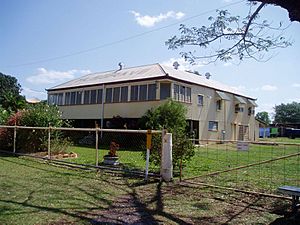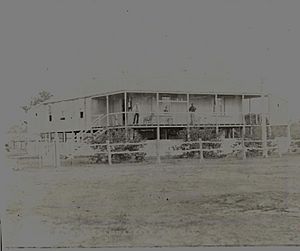Musgrave Telegraph Station facts for kids
Quick facts for kids Musgrave Telegraph Station |
|
|---|---|

Musgrave Telegraph Station (now road house), 2003
|
|
| Location | Peninsula Development Road, Yarraden, Shire of Cook, Queensland, Australia |
| Official name: Musgrave Telegraph Station (former) | |
| Type | state heritage |
| Designated | 21 August 1992 |
| Reference no. | 600431 |
| Lua error in Module:Location_map at line 420: attempt to index field 'wikibase' (a nil value). | |
The Musgrave Telegraph Station is a historic building in Queensland, Australia. It used to be a telegraph station, which sent messages over long distances using electric signals. Today, it's known as the Musgrave Roadhouse, a place where travelers can stop for food, fuel, and rest.
This important site is located on the Peninsula Developmental Road in Yarraden. It was added to the Queensland Heritage Register in 1992 because of its special history.
Contents
History of the Musgrave Telegraph Station
The Musgrave Telegraph Office opened in 1886. It was named after Sir Anthony Musgrave, who was the Governor of Queensland at the time. This station was a key part of the Cape York Telegraph Line. This line was a huge project that connected Laura (at the bottom of Cape York Peninsula) all the way to Thursday Island in the Torres Strait.
Building the Telegraph Line
The Cape York Telegraph Line was a major achievement for Queensland. It was surveyed in 1883 by John Richard Bradford. The first part of the line, about 320 kilometers (200 miles) long, was finished in 1886. The entire line used strong galvanized iron wire on steel poles imported from England.
The telegraph line helped isolated communities in the peninsula stay in touch. It also linked them to bigger cities like Cooktown and even further south. This communication was vital for Queensland's growth and for managing the northern parts of the state. It was also important for defense, especially for connecting with New Guinea and the Torres Strait.
Today, the Peninsula Development Road and Bamaga Road follow much of the old telegraph line's path. During World War II, the line was made even better. It became the main way for the Allies to communicate during their efforts in New Guinea.
Special Design of Telegraph Offices
Between 1884 and 1887, seven special telegraph offices were built along the Cape York Line. These buildings were designed in Brisbane and then shipped in pieces to be put together on site. Musgrave was one of these offices.
These offices were built with unique features. They had sliding shutters on the front windows and an inside verandah. They were also raised high on stumps, with space underneath for water tanks. These designs were meant to offer protection. Over time, as the need for these features changed, some parts were used differently or removed. The Musgrave Telegraph Office is the only one of these original seven buildings that still stands today.
People of the Station
Two graves are located near the Musgrave Telegraph Station. Sam Thompson, a linesman (someone who maintained the telegraph lines), died in 1919 after falling from a horse. He was buried under a mango tree. Billie Biernes, a mail contractor, also died at Musgrave and was buried nearby. Both were well-known people in the area.
In 1929, the telegraph services at Musgrave and other stations were closed. The buildings were sold by the government. The former Musgrave Telegraph Office then became a homestead (a main house on a farm).
What the Musgrave Station Looks Like Today
The former Musgrave Telegraph Station is now called the Musgrave Roadhouse. It's located on the Peninsula Developmental Road, about halfway between Cairns and Weipa. The site has several buildings, but the most important ones are the original Telegraph Office building (from 1886) and an old butcher shop. You can also see a remaining telegraph pole.
The Original Telegraph Office Building
The old Telegraph Office is a timber-framed building with a corrugated metal roof. It's built high off the ground on strong timber stumps. Part of the area underneath the building has been enclosed. You can go up to the main floor using a staircase at the back.
The front of the building has an enclosed verandah (a covered porch) with glass windows. The name "MUSGRAVE" is even painted in large green letters on the roof! A metal fence stands in front of the property, similar to how it looked in old photos. A single telegraph pole still stands behind this fence, right in front of the old office.
Other Buildings and Features
To the west of the old Telegraph Office, there's a square, single-story timber structure that used to be the butcher shop. It has a corrugated iron roof and a concrete floor.
Several large, old trees are on the property, especially near the road. A very big mango tree at the south-east corner acts as a marker for the station entrance.
Near the mango tree are the two old graves. One is clearly marked for Sam Thompson, the linesman who died in 1919. About 25 meters (82 feet) north of this, there's a slightly raised gravel patch. This is believed to be the unmarked grave of Billy Beirne(s), an early stockman and horseman.
The station is in a very remote area, surrounded by natural bushland. There are no other houses or buildings nearby. The Peninsula Developmental Road was still unsealed (dirt road) in the late 2000s.
Why Musgrave Station is Important
The Musgrave Telegraph Station was listed on the Queensland Heritage Register in 1992 because it meets special criteria.
Showing Queensland's History
The former Musgrave Telegraph Station, built in 1886, is a key reminder of Queensland's past. It shows how important the Cape York Telegraph Line was for connecting the colony's northern areas with Brisbane in the 1880s. This line helped the economy grow in northern Queensland. Even though it's not used for telegraphs anymore, its path is still followed by much of the Peninsula Development Road, and the station itself marks its history.
A Rare Part of Our Heritage
Seven special telegraph offices were built for the Cape York Telegraph Line between 1884 and 1887. These offices stretched from Laura to Thursday Island. The Musgrave office, built in 1886, is the only one of these original buildings that still exists. This makes it a rare and important piece of Queensland's cultural heritage, showing what was once a vital communication link.


